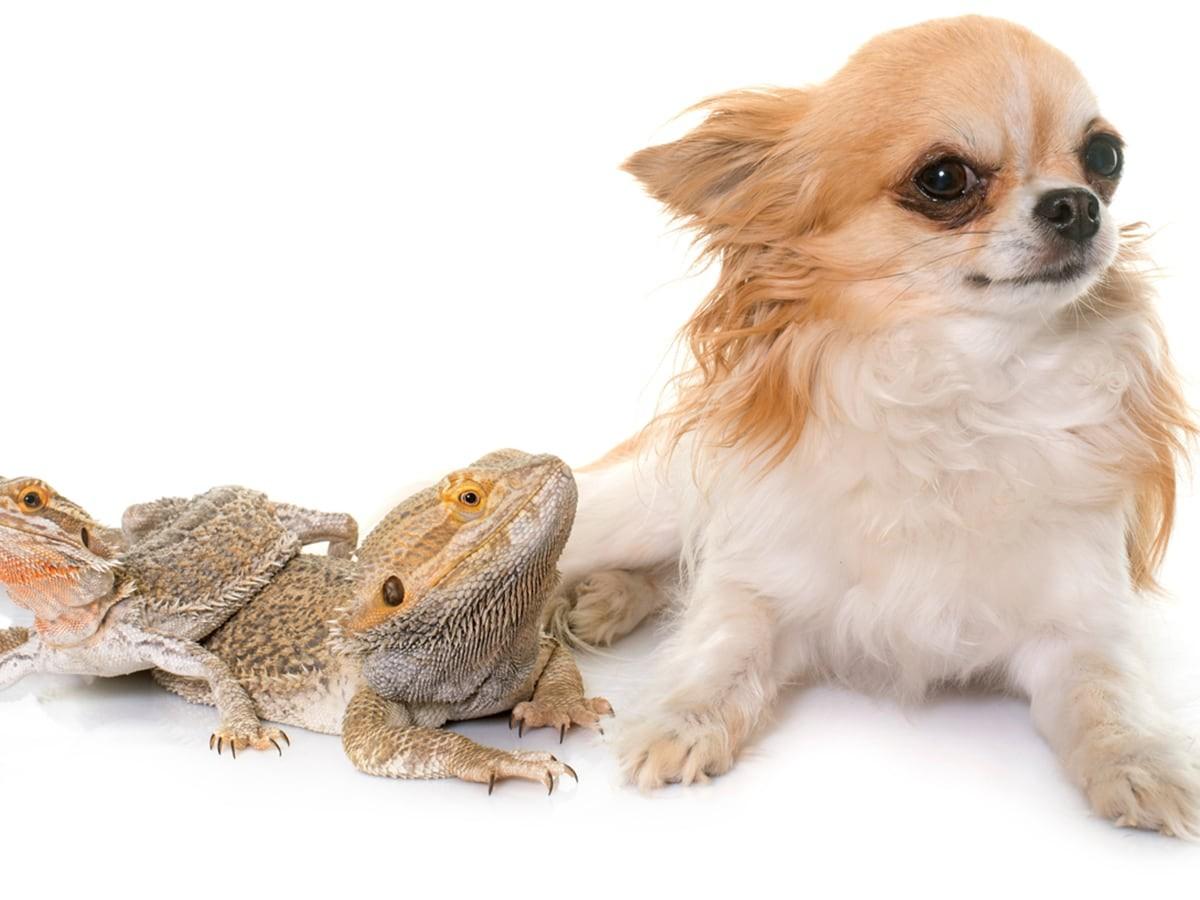Can Dogs, Cats and Lizards Get Along?
One of your responsibilities as a pet parent is to properly socialize all of your pets. Some may be surprised dogs, cats and lizards can get along. Every animal is unique. You might not know what happens when you clips a cat’s whiskers, why a dog’s fur changes colors and the best diet for reptiles.
Lizards and Pets
Are you considering adding a new reptile to your family? Part of this decision means making sure everyone will feel comfortable and get along. It can be tough introducing your new reptile to your other pets. As long as you introduce them in the correct way it can be done safely. If you’re stressed about your pets getting along, don’t worry! From cleaning tips for cat owners, microchipping your pets and keeping dogs safe in the car.
We’re here to help.
Keep reading to get some tips on how to facilitate a loving relationship between your pets of all shapes and sizes with introducing a second or third pet.
Tips for introducing your lizard to your pet
No two pets are the same. Some cats love to swim and others to hate it. There’s no perfect way to introduce new pets. You must be open minded. Never assume your pets will get along right away, even if they are usually very docile. If you’ve had your current pets for a long time, you likely know their personality well. Take their traits into account when introducing a new reptile and always be ready for anything! While there is no step-by-step formula for introducing your dog or cat to a reptile, there are some general rules of thumb you should always follow.
1. Supervise your initial pet interactions closely
For at least the first dozen meetings, you should be watching your pets engage with each other the entire time. This is to ensure that if something does go awry you are ready to jump in and fix the situation. It can be confusing for your pets to meet animals they’ve never seen before, and they might be unsure how to act. As they become more familiar with each other, you need to be present and engaged to make sure everything runs smoothly.
Start by being right alongside your pets when they meet. Hold your dog or cat’s collar and let them look at the reptile from afar. Then let them get closer to see and smell the new pet while still holding them to make sure they don’t do anything that could risk the reptile’s safety. As they interact more and more, you can become less involved. Let them get comfortable with each other but continue to supervise from afar. You must always be ready for something to happen because pets can be unpredictable when their environments change.
2. Allow your pets to have their own space
If your cat or dog has a favorite spot in the house, make sure to introduce them to your new pet in another area that’s neutral. This is because dogs and cats can be territorial over their favorite spot on the couch or the room they always hangout in. It’s safer to have your pets familiarize themselves in a neutral area to prevent territorial behavior. Keep this in mind when setting up your reptile tank. Avoid putting the tank in an area where your dog or cat sleeps or eats. These areas are part of your pet’s everyday routine, so putting the tank with a new animal in it can disrupt their comfort.
3. Have multiple meetings
Even if the first introduction between pets goes well, make sure to continue re-introducing them over time. As the pets continue to meet, try changing certain things about their environment so that your pets can become familiar with each other in different settings. Try changing the room in one meeting, then add your kids or other visitors in another meeting, then try short and extended periods of time where they can interact.
If one of these meetings doesn’t go well, avoid making any changes the next time they meet. Keep introducing them in that setting until they can get along. In addition, don’t make multiple changes at once. This can overwhelm your pets.
4. Identify stress behaviors
When your new pets are meeting, you need to watch closely to see if one or both of your pets are exhibiting behaviors indicating that they are stressed, scared, or uncomfortable. Even if your cat or dog is typically friendly, there’s always a chance they could react poorly to your reptile.
Common signs of aggression or stress for dogs and cats include stiff body posture, long stares, and growling, snarling, or barking.
Your lizard may also exhibit signs of stress. You should familiarize yourself with their body language to better understand when they are feeling uncomfortable. Some common signs include hissing, slowing waving its tail when another animal gets too close, and dropping its tail. If your lizard loses his or her tail, this is a sign that he or she is undergoing severe stress. This is a bad sign and the other animal should be removed from the area immediately.
3 reptiles that get along with dogs and cats
We know you want all your pets to be great friends, but sometimes this can be tough with pets from different species! If you want your furry friends and reptiles to get along, there are certain breeds of lizard that are more likely to be compatible with your existing pets than others. The top three lizard choices that will be good companions for your dog or cat are bearded dragons, leopard geckos, and blue-tongued skinks.
Bearded dragons are a great beginner pet because they are calm and sociable! These reptiles are very curious but gentle and they use their tongue to examine their environment. They have many social gestures that they typically only use with other beardies, but if you mimic them, they may respond to you as well! If your beardie feels threatened, they will puff out their spiky beard or turn it black. Watch out for this when they are interacting with your dog or cat. In addition, they may try to stare your pet down, bob their heads, or chase away threats. If introduced correctly, beardies will become very comfortable in an environment with other animals. They are very calm compared to other lizard breeds and shouldn’t have too hard of a time adapting to an environment with other pets.
Leopard geckos are similar to beardies in that they are docile and friendly. They are easy to take care of and love to be held once they are comfortable with their owner. They love to explore their environment and will climb on anything if you allow them to! Male geckos are territorial toward other male leopard geckos, but besides this they get along easily with other pets. These lizards use vocalizations like chirping, hissing, or barking to express their feelings. If they are hissing or barking when meeting your dog or cat, this means they feel threatened. If your gecko is hissing, waving his tail, or drops his tail, you should end the interaction immediately and give them a short break. Dropping their tail is a severe consequence of stress and should be avoided at all costs.
Blue-tongued skinks are another great option because their docile nature allows them to integrate well into different environments. While they are less social than bearded dragons and leopard geckos, they are very calm once they have acclimated to their environment. In the beginning they may be flighty, but after a short time they are easy to tame and will become comfortable. This breed of lizard is rarely aggressive, but if they are frightened by your dog or cat then they may stick out their blue tongue, hiss, and puff out their body. Like a gecko, they may drop their tail if they are very scared.
Although there are many differences between dogs, cats, and lizards, they can all become great friends with proper socialization. Remember to always be careful with them and prioritize the animals’ safety!
Key Takeaways
Although it is more than possible for your furry friends to have a happy, healthy relationship with reptiles, there are things to look out for. Dogs and cats are predators and lizards can sometimes be seen as prey. It is imperative that you facilitate proper introductions between
pets so that your larger animals see your lizard as a friend, not food. In addition, sometimes reptiles can carry diseases that may harm your other pets. Make sure to take them to the vet and test them for diseases such as salmonella before introducing them to your pets at home.
Once you have taken the proper safety measures, sit back and watch as your pets become friends! It may take some time, but once they are comfortable with each other they will develop a bond.

The resident animal enthusiast at Spot. I have a lifetime of pet parent experience. If it has fur, feathers, or scales, I’ve probably shared my home with it. I aim to be a reliable source, blending experience with a dedication to the well-being of pets.
Dogsbestlife
Aniwmalwellnessmagzine
Cheatsheet












